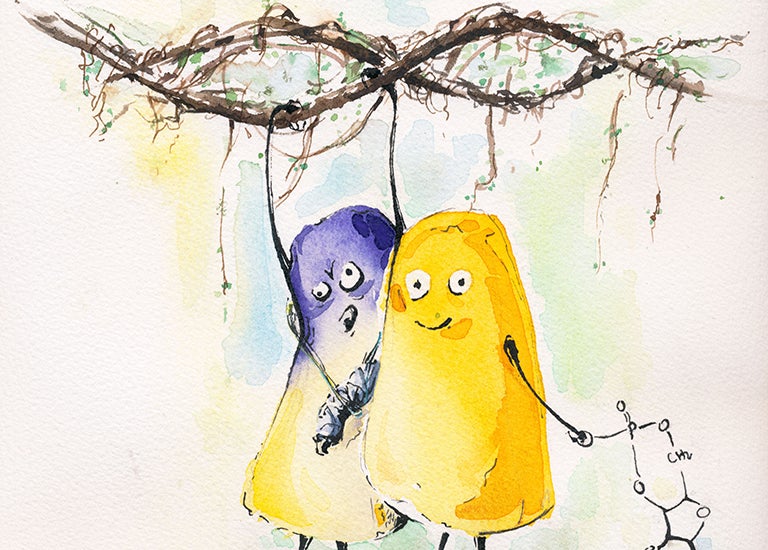Maillard Paper Named Editor's Pick

Chemistry professor Rodrigo Maillard’s paper was named an Editor’s Pick in the Journal of Biological Chemistry this month. Third-year Ph.D student Sahar Foroutannejad created this accompanying illustration, which depicts the protein at the center of the study.
April 10, 2016 — When chemistry professor Rodrigo Maillard’s manuscript “Asymmetric Configurations in a Reengineered Homodimer Reveal Multiple Subunit Communication Pathways in Protein Allostery” was selected as an Editor’s Pick at the prestigious Journal of Biological Chemistry this month, it meant more to the 3rd-year professor than just a big splash for his lab.
Maillard had conceived of the idea behind this paper — the first from the Maillard Lab at Georgetown — as a graduate student at the University of Texas Medical Branch in 2003. It wasn’t until this past year that he had the resources to try it.
“Asymmetric Configurations in a Reengineered Homodimer Reveal Multiple Subunit Communication Pathways in Protein Allostery” describes a new finding on the behavior of mutations in a protein in the bacteria Escherichia coli. Essentially, Maillard sought to understand whether the behavior of negative-dominant mutations — proteins where mutations in only part of the structure lead the entire protein to malfunction — could be manipulated to improve their function.
The answer? Yes — but it’s complicated.
Maillard and his team created a protein chimera, a lab-engineered hybrid that imitates the behavior of real-life proteins but can be precisely manipulated by researchers. They attempted to change the protein’s behavior by changing the proportion of “good” structure to “bad’ structure, and in doing so discovered that the reality of negative-dominant mutations is more nuanced than scientists previously believed.
“We can assess in a very controlled fashion how the entire chimera behaves,” Maillard said.
The Georgetown team studies many combinations of functional and nonfunctional protein parts, experimenting with different mutations to assess the effects on the protein’s overall function.
Engineering mutations that enhance function, it seems, can make the protein behave better than it did before, even though the overall effect is still not an optimally functioning protein. While the mutated (bad) effect still dominates, the idea that this process can operate on a spectrum — rather than any mutated genes dooming the protein — is a new revelation.
“Imagine you have five positive protein parts and five negative parts,” Maillard said. “Intuitively, if you mix them, you’d expect the molecule to be neutral. It’s not — it’s still negative. But the ‘dominant negative effects’ don’t truly dominate when you have a hyperactive positive component. The positive component would ‘rescue’ it, at least a little bit.”
Maillard’s discovery came as the result of constant, painstaking work. It took his team over a year of trial-and-error protein manipulation, with few signs of whether they were on the right track.
“Nature has done things for a certain reason,” Maillard said. “Forcing it to be a way it doesn’t want to be…it takes a lot of back-and-forth. And you don’t know if you’re 10 miles away or 100 yards away.”
Plans for further research on the topic include examining why negative-dominant mutations tend to dominate over positive ones, and whether adding positive mutations or drugs that enhance activity of good parts pushes the protein closer to full function. A more ambitious goal is to directly study mutant proteins that are related to cancer cells — p53, for example, a cell division-regulating protein whose malfunction is associated with cancerous growth.
“It’s a very complex protein,” Maillard said. “Imagine we’re working with a simple one-level house — this would be a mansion. But that’s where we would like to go.”
Still, Maillard is excited that his unique approach has landed his lab a spot in the Journal of Biological Chemistry.
“It’s a big honor,” Maillard said. “It’s humbling that very established people are seeing that the work coming from our lab is important.”